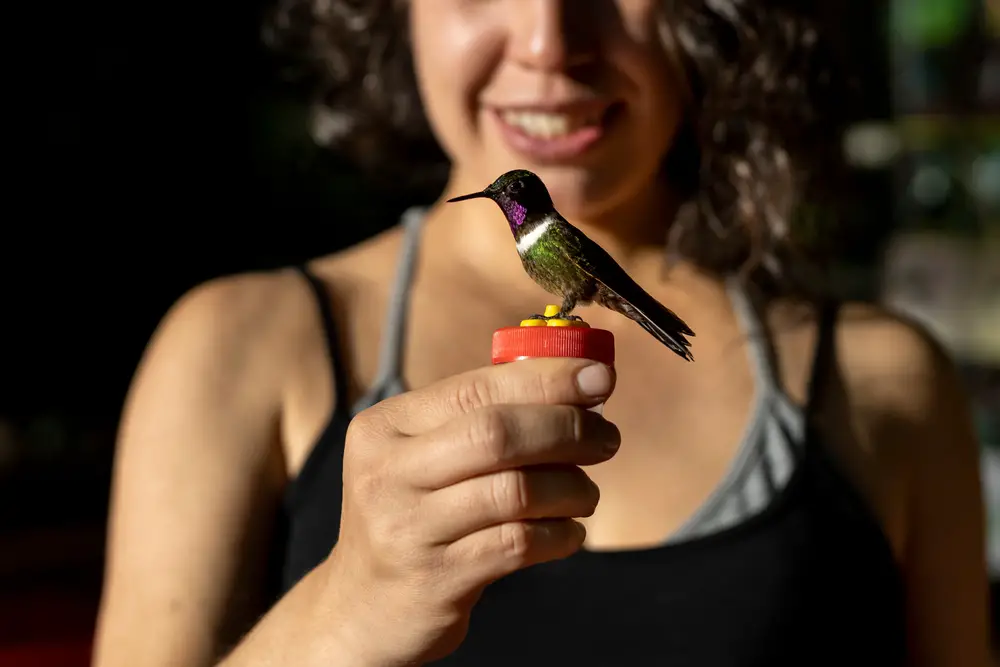Hummingbirds are not capable of walking on their little hummingbird feet. They can only perch on branches and feeders. The reason for this is that they need to conserve all of their energy for the task of flying. Hummingbirds do sleep and mate while perched on their feet.
When you think of birds, you can imagine plenty of them having feet. But with hummingbirds – It’s hard to tell as most of the time they are flying rather than hopping around. Hummingbirds are the smallest birds in the Americas, and they move so fast that it almost seems like they don’t have feet.
Their tiny hummingbird feet are not as interesting as their iridescent gorgets and beautiful tail feathers. But there is more than meets the eye for these hummingbirds! It turns out hummingbirds have feet that are not so apparent at first glance. That’s because a hummingbird’s wings shelter them. That is, they are tucked under these perfectly-designed flappers.
Hummingbirds are Apodiformes, which means footless in Latin. But even if they’re part of that family, they have legs. Their tiny legs are scuffed into their bodies, making them more aerodynamic than other birds. They can also be considered “footless” because they don’t use their feet for the same purposes as most creatures. Hummingbirds have evolved this way, and will probably never been seen hopping or walking on their feet.

Table of Contents
Do hummingbirds walk?
Hummingbirds do not walk, they are incapable of doing so. They don’t have to, being that they have fantastic flight skills. But that doesn’t mean their feet are useless. Hummingbirds use their feet for perching while eating and mating, and for an occasional sideway scooch. Their feet are also used for during their grooming sessions, removing mites and other insects, gathering their nesting materials, building their nests, and scratching when fighting.
Of all these actions, females use their legs the most when building their hummingbird nest (gathering materials for the nest and gluing it all with spider webs) and fighting off predators (especially after the baby hummingbirds hatch). Male hummingbirds use their legs especially to fight off and repel intruders (they mostly use the claws) – the perfect weapon to assist their territorial behavior.
Their feet also help them hang upside down when they enter a state of torpor (a type of hibernation that they can go through to slow down their metabolism and heart rate). But other than that, hummingbirds don’t need their feet; their wings do most of the things for them:
- Aiding in the search for food and the act of feeding
- When they do their acrobatic mating-call movements.
- Migrating away from the cold during the change of seasons.
Since hummingbirds are the only birds that hover and fly backward, most people are taken by their flight capabilities. When a hummingbird flies, it looks and sounds like a teeny-tiny helicopter that hovers around incessantly. And their wing rate can go up to about 80 flaps per second, which is the fastest rate of any bird. Yes, they may not have functional legs, but they’re not missing out on all that much, don’t worry.
What do hummingbird feet look like?
Hummingbird legs are very short and their feet look like scrawny little claws with four long toes – three toes at the front and one in the back called a hallux. The hallux looks like a human thumb, and it’s typically used for gripping, which makes sense if you think about it. They don’t look like other birds’ feet, and they aren’t really able to use them as other birds would.
One of the reasons why walking is impossible for these little birds is that hummingbird feet don’t have knees. Without a knee joint, walking would look unnatural for a hummingbird – like two sticks and don’t bend. If you want to see those little hummingbird feet in action in your garden, you can always put a

Facts about hummingbirds
A study conducted in 1978, indicates that hummingbirds have relatively strong feet comparable to the strength of their bills:
“Hummingbirds use their feet not only for perching while at rest but also for perching while feeding. Some birds … seem to perch whenever possible while feeding, even vertically or upside down, and have relatively large, strong feet (Colwell, unpublished). This behavior clearly saves energy, compared to hovering.“
Community Organization Among Neotropical Nectar-Feeding Birds – Peter Feinsinger & Robert Colwell
And although hummingbird feet may in fact be quite impressive, here are other outstanding qualities that make hummingbirds so unique:
- A Hummingbird’s heart rate is very high reaching up to 1200 beats per minute – now that’s no small feat!
- Hummingbirds’ dynamics are fascinating! They can hover, fly backward, and even sit upside down (especially when sleeping or in torpor). They are so good at flying that they even fight mid-air and do impressive dives when they mate.
- Hummingbirds are typically small birds with a constant hunger for food – they eat double their body weight and are known to fight when scavaging for food supplies.
- The most common hummingbird species is the Ruby-throated hummingbird (Archilochus colubris) – especially in the US. But even their numbers are starting to decrease. When thinking about our hummingbirds, one must consider how climate change can eventually affect their food supply and migration patterns.
How can you help hummingbirds?
If you want to see these jewels fly around and spot their teeny-tiny feet, it would be best to “lure” them with some sweet nectar. We can all help hummingbirds maintain their rich diet by providing as many food sources as possible (in the form of hummingbird feeders with homemade nectar and beautiful tubular red flowers).
They are also very adaptable and can hunt small insects for themselves. We know hummingbirds are wild birds, but they will never refuse a nectar feeder – especially after migrating a long distance (like the Rufous hummingbird, which travels for thousands of km).

